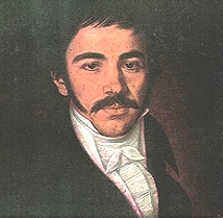
Vuk St. Karadžić (1787-1864) |
|
Works of Vuk St. Karadžić constitute a distinct
part of the Corpus. In contrast to other subsamples, this segment of the
Corpus is not a sample since the complete works of Vuk St. Karadžić are
grammatically tagged in full. Due to this, there are several distinct parts
of his works that constitute this segment: Serbian national poems, Serbian
national stories, translation of the New Testament, the Serbian dictionary,
Karadžić's historical and ethnological studies, his linguistic studies
and his correspondence. The complete works of Vuk St. Karadžić have ....
words. Partially the material in Corpus is based on complete Karadžić's
works
|
edited and published by Ljubomir Stojanović
in the first part of the 20th century, while some parts are based
on editions published in the mid 1950's. It should be noted that material
does not correspond in full to the latest edition of Karadžić's complete
works which contain some documents that were not available at the time
when the Corpus was built.
The whole material is transferred into an electronic format. Each word
is lemmatized and tagged for its grammatical status, and annotated for
page and line in the book. Proofreading of the material is in progress.
Vuk St. Karadžić (1787-1864) is by all means the most prominent
figure of the 19th century Serbian culture and one of the most prominent
figures of Serbian history. The significance of his contribution is difficult
to grasp in full due to variety of his activities and engagements, on the
one hand, and the impact of his reforms of Serbian language, which
had both cultural and political implications, on the other.
In an attempt to make systematic overview of his contribution two distinct,
but complementary lines of activity, as well as number of other activities,
can be traced.
a. The first line of activity is related to the reform of Serbian orthography.
From a non-systematic and, to a large extent, chaotic Serbian language
orthography of the 18th and the first part of the 19th century, Karadžić
introduced radical reforms with long-term consequences. Karadžić established
a phonemic orthography where a single grapheme corresponds to a single
phoneme. This seemingly simple principle implies deep insights about the
nature of a phoneme, i.e. the minimal distinct unit of meaning. After identifying
30 phonemes of Serbian language, Karadžić restricted Serbian alphabet to
30 corresponding graphemes. In 1812 he wrote the first Serbian primer (»Pismenica«)
based on the new orthography and in 1818 he compiled and published first
dictionary of Serbian language, also written in the new orthography.
b. The other line of Karadžić's activity is tied to the standardization
of Serbian literary language. Serbian literature of the 18th and the beginning
of the 19th century was not only written in an unstandardized orthography,
but also in a unstandardized language that was spoken by small number of
upper class and educated people. Breaking radically with this tradition,
Karadžić introduced the national language as a literary standard. For this
language he wrote grammar and dictionary.
c. In addition to these two main lines of activities, Karadžić made
great contribution to Serbian historiography (writing a history of the
First Serbian uprisal), founded Serbian ethnology (collected Serbian proverbs
and narodni običaji), translated the New Testament into Serbian and collected
Serbian national poems and stories.
d. In addition, the historical significance of Vuk St. Karadžić was
in his successful attempts to make closer contacts between Serbia (at that
time under Turkish occupation) and Europe. Through his contacts and collaboration
with J. W. Goethe, G. Grimm, L. Ranke and other prominent scholars of that
period, Karadžić introduced Serbian national poems and culture into Europe.
Serbian national poems were translated into almost all European languages
(....)
This short overview of his activities unveils the reasons why Karadžić's
works were incorporated in full into the Corpus. His complete works encompass
all significant periods in creation of standardized Serbian language and
orthography. On the other hand, they allow for comparisons between the
national and literary languages prior to his reforms. Finally, they enable
contrasts between the language of Karadžić himself (i.e. through his correspondence)
and various forms of the contemporary Serbian language. |